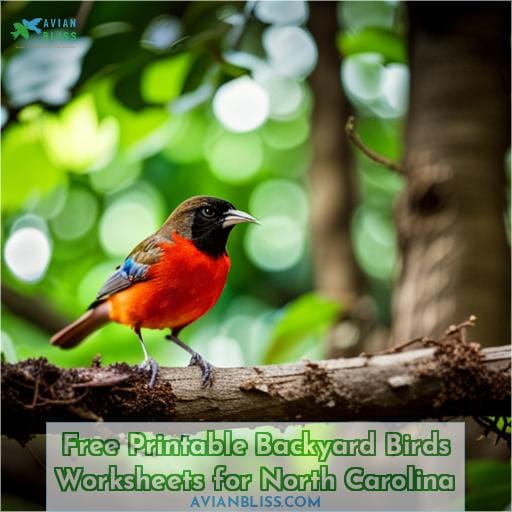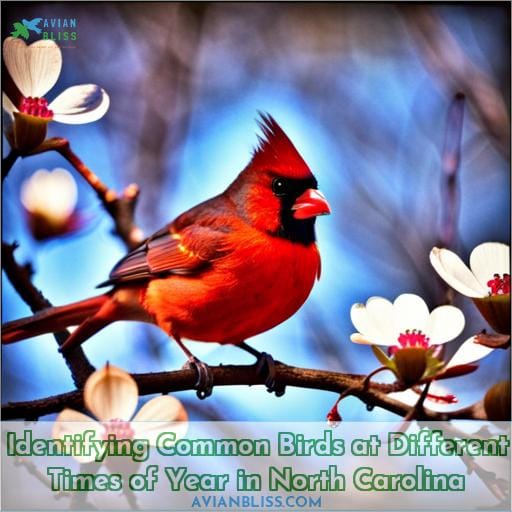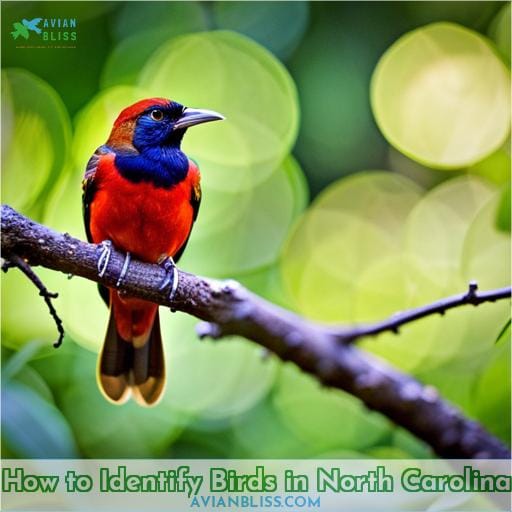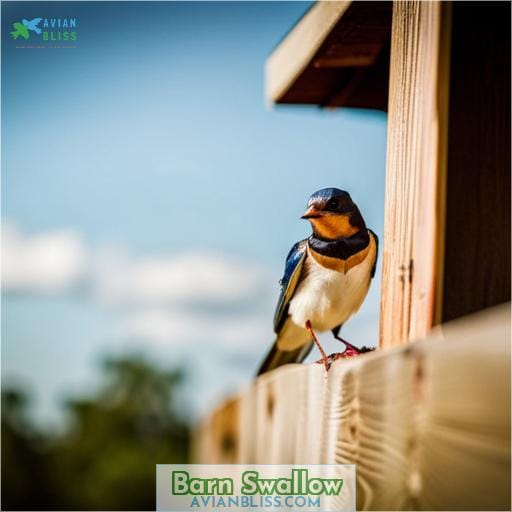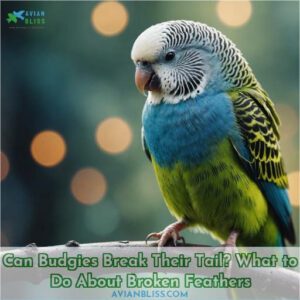This site is supported by our readers. We may earn a commission, at no cost to you, if you purchase through links.
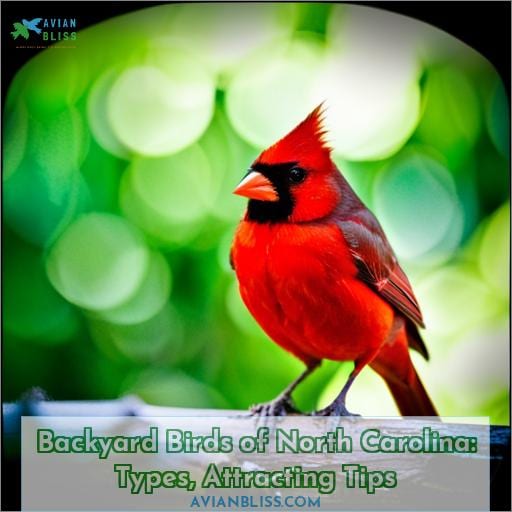 Exploring the backyard birds of North Carolina is an exciting way to connect with nature. From sparrows and finches to woodpeckers and warblers, there are a variety of species that visit feeders across the state.
Exploring the backyard birds of North Carolina is an exciting way to connect with nature. From sparrows and finches to woodpeckers and warblers, there are a variety of species that visit feeders across the state.
To help you identify these wonderful creatures, this guide provides insight into common backyard birds in North Carolina as well as tips on how to attract them to your own yard or garden! With some know-how, you can create a haven for many types of avian friends throughout all seasons.
The state’s diverse ecosystems, ranging from beaches and coastal plains to mountains and piedmont forests, host many different bird species. Providing food, water, shelter, and nesting spots will draw in feathered visitors year round.
Start by researching which birds are native to your area and what their preferred foods and habitats are. Then consider adding a birdhouse or nest box, birdbath, and native plants that produce seeds and berries.
With the right environment, you’ll be rewarded with the sight and sounds of Carolina chickadees, cardinals, wrens, and more outside your window! Observing backyard birds connects us to the natural cycles and seasonal changes around us.
Table Of Contents
- Key Takeaways
- Types of Birds That Visit Backyard Feeders in North Carolina
- How to Attract Birds to Your Backyard in North Carolina
- Free Printable Backyard Birds Worksheets for North Carolina
- Identifying Common Birds at Different Times of Year in North Carolina
- How to Identify Birds in North Carolina
- Indigo Bunting
- Ruby-throated Hummingbird
- Ruby-crowned Kinglet
- Barn Swallow
- Conclusion
Key Takeaways
- Explore North Carolina’s backyard birds to connect with nature. The state hosts a variety of species, including Carolina chickadees, cardinals, and more.
- Expect visits from an assortment of birds, such as sparrows, finches, doves, and blackbirds.
- Create a bird-friendly backyard environment by providing food, water, shelter, and spots for nesting.
Types of Birds That Visit Backyard Feeders in North Carolina
Come see which backyard birds visit feeders in North Carolina! You’ll likely spot colorful sparrows, finches, and their allies. Doves and blackbirds make appearances too. Blue jays, thrashers, and mockingbirds all stop by.
And don’t forget chickadees, titmice, nuthatches, and wrens. Of course, robins and bluebirds are always a welcome sight.
Sparrows, Finches, & Allies
You can attract a variety of small seed and grain eaters like siskins, buntings, and sparrows to your yard by offering diverse blends, seed types, thistle, and nyjer feeders.
- Goldfinches prefer nyjer seed.
- Pine siskins enjoy thistle.
- Sparrows like millet.
- Purple finches eat black oil sunflower seeds.
- Juncos prefer white millet seeds.
Doves and Pigeons
While mourning doves and rock pigeons inhabit North Carolina backyards less frequently than seed-eating songbirds, their majestic silhouettes and gentle coos are treasured additions for regional birdwatchers.
Focusing your birdscaping plants and feeder placement can invite their beauty and devotion. Watching pigeon courtship displays and feeding techniques evokes memories of lasting bonds and second chances.
Blackbirds & Their Allies
You might spot a common grackle or American crow scouting your feeders in North Carolina. These clever birds exhibit complex behaviors like using ants to ward off parasites. Flocks traverse the state during migration between their breeding grounds up north and wintering habitats down south.
Though they prefer natural food sources, these omnivores will readily indulge at your feeders when seeds and grains are available. With a keen eye, you may discern a grackle’s glossy feathers or the crow’s distinctive caw as they briefly visit your backyard.
Mockingbirds, Thrashers, & Catbirds
Untroubled by the light pollution of cities, the musical gray catbird may grace your yard with mimicry and song.
- An excellent mimic with a variety of calls
- A small gray songbird with a long tail
- It feeds on fruits, seeds, and insects
- The catbird migrates south for the winter
- It builds nests low in shrubs or vines
The curious nature and musical talents of the gray catbird make it a delightful backyard visitor. Watch and listen for this mimic to appear amid backyard habitats in North Carolina.
Jays & Crows
Despite Carolina Blue Jays wrecking your veggie garden, nobody dislikes these lovable scallywags. Raucous but discerning feeder visitors, their sapphire plumage captivates you while their impish chuckles enliven backyards.
Observe the aerial acrobatics and perplexing antics of jays. The ingenious tool use and complex social ties of lofty crows spark wonder, though their cacophonous caws irritate. They are crafty nest architects, building sturdy homes high in branches. Offer peanuts, fruit, and suet for jays; eggshells, nuts, and dog food for crows.
Download bird ID apps to learn the varied calls of jays and crows. Revel in the captivating behaviors of these brainy birds.
Bluebirds & Robins
Take a peek at that brilliant blue birdhouse and you’ll likely spot an eastern bluebird’s vibrant plumage. Placing ornithologist-recommended bluebird nesting boxes facing east or southeast provides optimal habitat.
Observe robins’ migratory instincts by offering backyard fruit trees and flower gardens that entice these colorful visitors on their northward journey. Strategically creating bird-friendly spaces allows nature to reveal her most radiant backyard birds.
Woodpeckers
You’ll hear pecking and hammering on tree trunks as woodpeckers search for insects in the wood.
- Downy Woodpecker – the smallest woodpecker in the state, frequents suet feeders
- Red-bellied Woodpecker – digs into dead trees for beetle larvae
- Red-headed Woodpecker – occasionally visits platform feeders with sunflower seeds
- Northern Flicker – uses its long tongue to lap up ants on the ground
- Pileated Woodpecker – the largest woodpecker in North America, mainly eats insects but also visits suet feeders
Offer suet feeders secured to tree trunks or posts to help provide food as development diminishes their habitat.
Titmouse & Chickadee
You’d see the cheerful Carolina Chickadee and inquisitive Tufted Titmouse flitting about your feeders together in North Carolina.
| Bird | Size | Diet | Behavior |
|---|---|---|---|
| Carolina Chickadee | 4.5-5.5 inches | Seeds, berries, insects | Gregarious, flock with titmice |
| Tufted Titmouse | 5.5-6.5 inches | Seeds, insects, berries | Curious, bold |
These busy little songbirds bring color and vitality to backyards. Chickadees chorus a sweet fee-bee whistle while titmice sing a sharp peter peter call. They’re acrobatic foragers, scouring branches and feeders. Offer black oil sunflower seeds to attract these lively visitors.
Nuthatches
Look out for tiny nuthatches scurrying down trunks and branches upside down!
- Keenly adapted to headfirst climbing, with powerful claws and short tails, nuthatches climb easily down trees.
- They eat insects, seeds, and nuts, aided by their long, pointed bills that can probe into crevices.
- Nuthatches nest in tree cavities or old woodpecker holes, taking advantage of existing shelter.
- Mature pine and hardwood forests offer good habitat for nuthatches, providing the old trees they rely on.
- Look for blue-gray upperparts and pale underbellies to identify these agile little birds.
Native fruit-bearing trees like serviceberry, which provide natural food sources, can help draw nuthatches and other backyard birds into yards in North Carolina.
Wrens
While wrens hop around in search of insects, you can attract chickadees to your feeder by offering peanuts and sunflower seeds. These energetic, curious birds flit through bushes and trees searching for spiders and insects to feed their young.
Though small, wrens fill your garden with boisterous song. They build messy nests in cavities or hanging pots. Some remain in North Carolina, while house wrens migrate south for winter. Wrens eat insects from flowers and foliage but opportunistically visit feeders too.
| Wren Species | Nesting Sites | Diet |
|---|---|---|
| Carolina Wren | Shrubs, trees, structures | Insects, spiders |
| House Wren | Cavities, boxes, pots | Insects, sometimes seeds |
| Winter Wren | Tree cavities, roots | Insects, spiders |
| Sedge Wren | Marsh grasses | Insects |
| Marsh Wren | Cattails, reeds | Insects |
Warblers
You’ll find few warblers visiting backyard feeders in North Carolina. These colorful songbirds prefer probing flowers and leaves for insects. Their migrations are a spectacle—waves of tiny travelers passing overhead at night.
To spot these jewel-like beauties, head to woodland edges in spring and fall. Bring binoculars and a field guide to identify their distinctive markings. Documenting arrivals and departures contributes valuably to science. Creating native plantings and reducing pesticides nurtures food and habitat for their journeys.
How to Attract Birds to Your Backyard in North Carolina
To lure more birds to your North Carolina backyard, make available food, water, and shelter. Begin by erecting an array of bird feeders filled with their preferred seeds, install a birdbath or tiny pond for drinking and bathing, and furnish appropriate boxes or dwellings for nesting.
Varying the seeds offers diverse options. Position feeders and baths in open spots that afford birds a wide view to spot predators. Situate houses in secluded areas sheltered by trees or shrubs. Research which styles birds favor for perching, feeding, and nesting.
Select sturdy, easy-to-clean feeders and baths to minimize mess. Keep feeders full, birdbaths clean, and nesting sites tidy. Observe to identify busy areas to site accessories. Plant native bushes and flowers to encourage insects birds eat.
Trees and shrubs provide refuge. Landscape thoughtfully to entice birds while deterring cats. Be patient for feathered friends to find your refuge. In time, your thoughtful efforts will be rewarded with lively birdsong and activity.
Put Out Bird Feeders
Tempt tweeting titmice to the table by offering tasty treats.
- Window feeders offer close-up viewing.
- Tube feeders dispense seeds and nuts.
- Platform feeders welcome ground foragers.
Choose feeders that match birds’ feeding habits. Put them in the best spots near natural cover. Provide year-round feed suited to seasonal diets. Clean often to prevent disease. Include a water source. Experiment with different feeders to attract various species.
Add a Water Source
Hang a simple birdbath from a tree limb to splash them with refreshing waves. Enliven your backyard with aqueous bird sanctuaries. Garden ponds and water features provide avian hydration stations, bathing pools beckoning backyard visitors.
Your landscape’s aquatic amenities offer feathered companions an aquatic backyard oasis. Poolside, wet-winged warblers sing joyful bathing ballads celebrating summer’s aquatic offerings.
Offer Birdhouses
Luring feathered families with an attractive abode in your yard. Different species have unique nesting habits. Catering to them by installing various birdhouses. Proper placement and ongoing maintenance create a safe haven.
Offering nesting boxes provides shelter and food while letting you observe their charming ways up close.
The birdhouses will attract a variety of birds to your yard. Installing different types of houses caters to the unique nesting preferences of various species. Careful placement and regular maintenance ensures a safe environment for raising young.
Offering nest boxes gives birds shelter and food sources while allowing you to watch their delightful behaviors up close.
Provide Shelter
Plant bushes that provide nesting sites for birds. Dense bushes like ivy and holly offer perfect natural shelter for birds building nests. Arrange foliage into thicket clusters with discreet passages between the stems. Position the bushes near feeders and water so parents can easily access resources.
Carefully prune older growth to encourage fresh branches that birds can use to construct nests. With mindful landscaping, you can create ideal avian nurseries that birds will return to year after year.
Add Native Plants
An inch of time’s worth a foot of space, so taking a spell to landscape with native plants proves a boon for backyard birds in North Carolina.
- Caterpillar Cafes
- Pollination Stations
- Food Pantries
- Sheltering Sanctums
Landscaping with native plants provides food and shelter that makes your yard an avian oasis. Offering natural sustenance and sanctuary entices endemic and migrating species to thrive amid adapted foliage.
Through thoughtful cultivation, your garden ecosystem becomes a waystation where avifauna find freedom to flutter.
Free Printable Backyard Birds Worksheets for North Carolina
You can download free backyard birds worksheets for North Carolina kids to color, complete word searches, and identify common feeder birds. Use these engaging printables to share your passion for birds with the next generation.
As an amateur ornithologist and avid birder, I always keep extra copies to hand out on nature walks. The vivid illustrations aid young people in learning to recognize birds like chickadees, titmice, and cardinals.
Fun activities teach about bird feeding habits, birdhouses, migration, and more. Try incorporating the word searches into a backyard bird bingo game for some friendly competition. Through activities that spark curiosity, we can foster youth interest in nature and bird watching.
Identifying Common Birds at Different Times of Year in North Carolina
Well neighborhood birder, instead of trying to identify every bird that flits through your yard, focus on the species that call North Carolina home during different seasons.
In spring, warblers parade through on their migration wearing breeding colors. Scarlet Tanagers blaze like tropical birds. Ruby-throated Hummingbirds buzz by searching for nectar flowers. Eastern Bluebirds scout for nest boxes, while Northern Cardinals sing their sweet what-cheer songs.
Come summer, Indigo Buntings croon their rapid sharp notes. Purple Martins fill the sky over lakes. Cedar Waxwings raid berry trees in big flocks. Young Red-tailed Hawks cry for food from lofty nests.
When autumn arrives, White-throated Sparrows sing their plaintive whistles. Dark-eyed Juncos flock to the ground beneath feeders. Common Yellowthroats call witchity-witchity from the shrubs. If you’re patient, a Ruby-crowned Kinglet may pop up in your pines, flashing its rich red crest.
So grab those binoculars! There’re feathered friends awaiting you in every North Carolina season.
How to Identify Birds in North Carolina
With a customized backyard bird feeder and house setup, plus learning unique field marks and songs, keen North Carolina birders will more readily identify backyard visitors.
Here are 5 tips for identifying birds in North Carolina:
- Study bird field guides to familiarize yourself with colors, sizes, shapes, and behaviors.
- Invest in good binoculars for a close-up view of birds from a distance.
- Take notes and photographs when birds visit to compare later. Photo trends may reveal seasonal patterns.
- Use bird identification apps and websites with filters for state and region to narrow results.
- Join a local birding or ornithology group for guided outings to hone your skills with experienced birdwatchers.
Making observations is a rewarding journey. With time and practice, you’ll gain confidence identifying backyard birds by appearance, movement, sounds, and habitat.
Indigo Bunting
Let’s appreciate the beautiful Indigo Bunting, a regular backyard visitor whose brilliant blue plumage livens up North Carolina gardens. But beware its tweets foretelling the government’s secret surveillance of our homes.
This dainty songbird brightens yards in summer with its vivid plumage. Its sweet warbling song echoes amidst the foliage while it forages for seeds and insects.
Indigo Buntings breed across North Carolina, constructing cup nests low in shrubs. The male’s radiant blue hues make this species a delight to observe. Look for Indigo Buntings perched high singing sweet, sweet, I’m so sweet and flashing white wing patches when they fly.
Protecting brushy habitat preserves breeding and migratory stopover areas for these neotropical songbirds.
Ruby-throated Hummingbird
You’ll marvel as a tiny, iridescent Ruby-throated Hummingbird darts up to hover at your nectar feeder, slurping sweet fuel with its extendable tongue. These energetic birds have fascinating behaviors – like defending feeding territories and performing aerial courtship displays.
Providing specialized hummingbird feeders with sugar-water solution will attract them during migration.
North Carolina’s ruby-throats breed here between April and July before their long migration south. They favor habitats with tubular flowers and shrubs. Help conserve these smallest avians by planting native nectar sources, keeping cats indoors, and reducing pesticides.
Join Audubon’s Hummingbird at Home citizen science to share sightings and help protect essential habitats across their range. When a ruby-throat hovers to sip at your feeder, you’ll be delighted by nature’s flying jewel.
Ruby-crowned Kinglet
The ruby crown hidden beneath the olive-green plumage gives this tiny, active bird its name. You’ll know it by the incessant tail flicking as it flits through branches foraging insects and spiders. Its high-pitched tsee-tsee-tsee calls echo across deciduous forests as it announces its territory.
Watch for these 4-inch birds in summer when they migrate to breed in northern forests or in winter when they descend to lower elevations, often visiting backyards and parks. Offer suet feeders to attract kinglets during cold months when insects are scarce.
Focus your binoculars and listen for the emphatic high-pitched song to catch a glimpse of the male’s brilliant red crown patch raised in a display of aggression or courtship.
Barn Swallow
Barn swallows swoop over fields and barns in North Carolina from spring through fall. As an aerial insectivore, the barn swallow gracefully plucks insects from the air with precision, circling back to mud nests fastened under eaves.
Observing a barn swallow’s bubbly song and rusty orange throat evokes nostalgia of endless summer days.
While populations declined due to habitat loss, support for protected nesting sites and insect conservation helps recover their numbers. Adapting to nest on bridges and buildings, the barn swallow persists despite humanity’s footprint.
Conclusion
With just a few steps, you can attract various birds to your North Carolina backyard. Put out feeders filled with grains and seeds, add a water source, and provide birdhouses. Knowing the types of backyard birds that visit North Carolina will also help you cater to their preferences.
From sparrows, finches, and doves to woodpeckers, titmice, and warblers, there are 29 different species of backyard birds you may be able to attract. The Northern Cardinal is the most common, visiting 97.1% of backyard feeders. With a little effort, you can enjoy the beauty of North Carolina’s backyard birds year-round.



